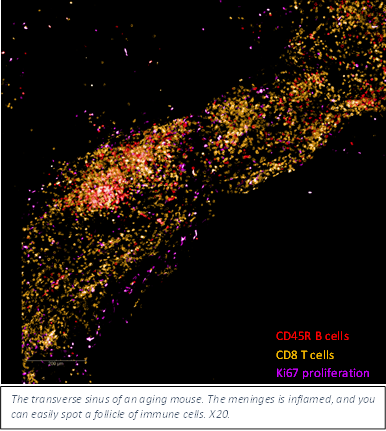Immune B cells are a part of the adaptive immune system and have a variety of functions in the body, from antibody secretion to antigen presentation for activation of other immune cells. Throughout their development, B cells go through stations in the body starting in the bone marrow, moving to the spleen and lymph nodes, ultimately activating, and working in the peripheral tissues. Tertiary lymphoid structures (TLS), also referred to as ectopic lymphoid structures, are immune structures found in various pathologies including solid tumors and brain pathologies such as multiple sclerosis. B cells have been recently implicated in the progression of Alzheimer’s disease (AD). Our recent data suggests that meningeal B cells are involved in TLS formation in both AD and aging.
To visualize TLS formations, we utilize Immunofluorescence staining on meningeal tissues of mice at various ages that model early onset AD and their control mice. In addition, the brain, superficial and deep cervical lymph nodes, spleen, and blood are collected for further analysis using Flow Cytometry. Specifically, we study which type or sub-populations of B cells make up these structures, as well as to see how these TLSs affect other cells in the parenchyma in relation to AD progression and inflammaging.

